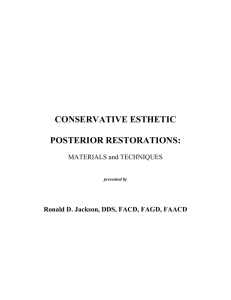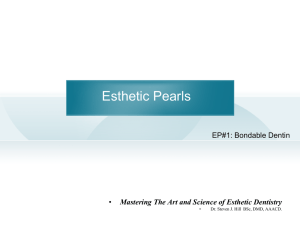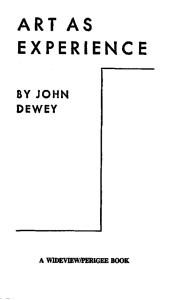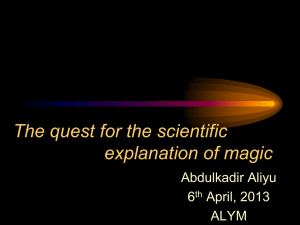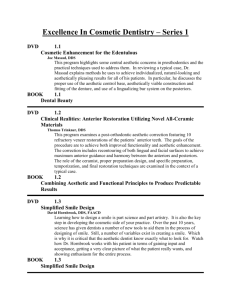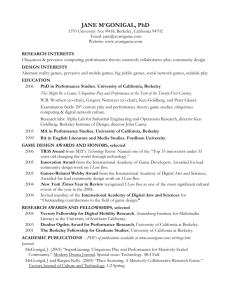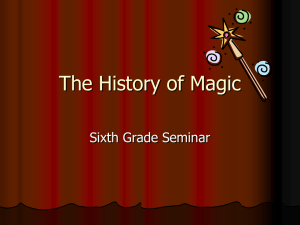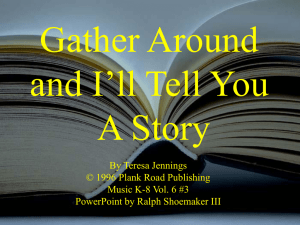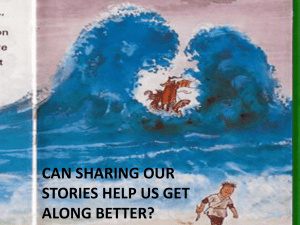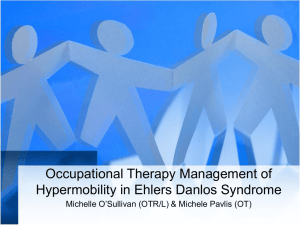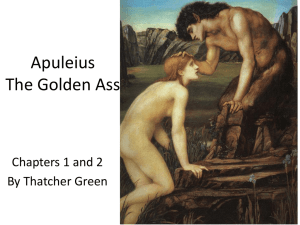Interatività, esperienza e creatività digitale – tra il gioco e social media
advertisement
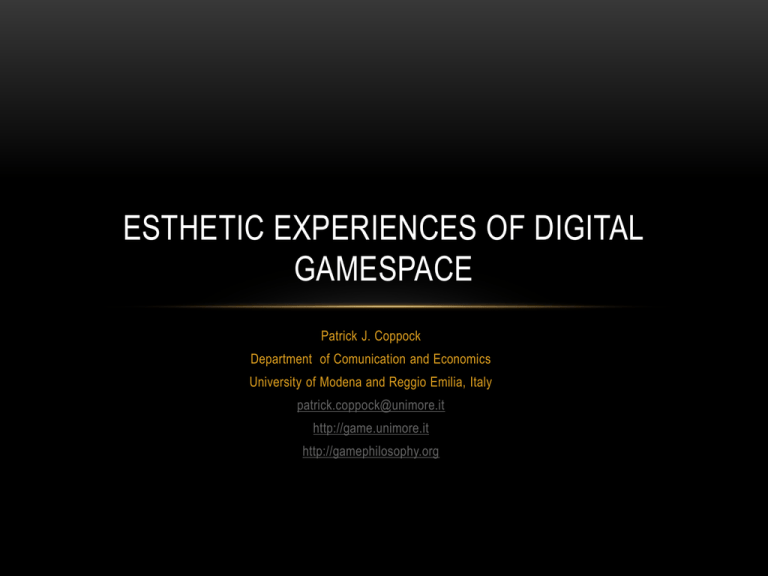
ESTHETIC EXPERIENCES OF DIGITAL GAMESPACE Patrick J. Coppock Department of Comunication and Economics University of Modena and Reggio Emilia, Italy patrick.coppock@unimore.it http://game.unimore.it http://gamephilosophy.org MY BASIC PREMISE • Computer games and their fictional gameplay spaces invite players to participate in meaningful playful interactions with, and within these spaces. • As digital cultural artifacts they constitute a new form of interactive art, and stimulate new types of ordinary esthetic experience. Game art - Assassin’s creed ii (piazza San marco ‘400) ORDINARY ESTHETIC EXPERIENCE • “What is pertinent to the topic of esthetic experience turns upon the way in which the material of past experience, which loads present attitudes, operates in connection with material provided by means of the senses” • “When artistic objects are separated from both conditions of origin and operation in experience, a wall is built around them that renders almost opaque their general significance, with which esthetic theory deals. • Art is remitted to a separate realm, where it is cut off from that association with the materials and aims of every other form of human effort, undergoing, and achievement.“ • “A primary task is thus imposed upon one who undertakes to write upon the philosophy of the fine arts. This task is to restore continuity between the refined and intensified forms of experience that are works of art and the everyday events, doings, and sufferings that are universally recognized to constitute experience.” ORIGINS OF ESTHETIC EXPERIENCE • “Because the actual world, that in which we live, is a combination of movement and culmination, of breaks and re-unions, the experience of a living creature is capable of esthetic quality. • The live being recurrently loses and re-establishes equilibrium with his surroundings. The moment of passage from disturbance into harmony is that of intensest life” ORDER (AS FORM) AND ESTHETIC EXPERIENCE • “Order cannot but be admirable in a world constantly threatened with disorder—in a world where living creatures can go on living only by taking advantage of whatever order exists about them, incorporating it into themselves. • In a world like ours, every living creature that attains sensibility welcomes order with a response of harmonious feeling whenever it finds a congruous order about it. • For only when an organism shares in the ordered relations of its environment does it secure the stability essential to living. • When the participation comes after a phase of disruption and conflict, it bears within itself the germs of a consummation akin to the esthetic.” Johan Huizinga: “the Magic Circle” Jesper juul: “the puzzle piece” Jesper juul: “the puzzle piece” • “the Magic Circle is the boundary that players negotiate” • “Game scholarship should be about analyzing the conventions of this boundary, and how and when this boundary is created.” • “Games are not exactly harmless, but have negotiable consequences”, the assignment of which is something that “can be negotiated on a play-by-play, location-by-location, person-to-person basis“ HUIZINGA AGAIN & .. MCGONIGAL / SZULBORSKI • “Play spaces are “temporary worlds within the ordinary world, dedicated to the performance of an act apart.” • “A play-community generally tends to become permanent even after the game is over. Of course, not every game of marbles or every bridge-party leads to the founding of a club. But the feeling of being "apart together" in an exceptional situation, of sharing something important, of mutually withdrawing from the rest of the world and rejecting the usual norms, retains its magic beyond the duration of the individual game.” • Jane McGonigal, Dave Szulborski: ARG players always juggle two conceptual frames: • This-Is-A-Game (T-I-A-G) • This-Is-Not-A-Game (T-I-N-A-G) LARP-ING AROUND AUGMENTED REALITY JANET MURRAY: INTERACTOR/PLAYER AGENCY • “Every digital project is involved spatializing in some form, including maps, information spaces, locations of the real world, virtual places. • In all these environments, designers should focus on providing agency in navigation by clearly indicating the current location of the interactor, the relationship among the elements that are within the digital site, and the extent and location of boundaries.” ESTHETICS & ORDINARY EXPERIENCE • “Even a crude experience, if authentically an experience, is more fit to give a clue to the intrinsic nature of esthetic experience than is an object already set apart from any other mode of experience. Following this clue we can discover how the work of art develops and accentuates what is characteristically valuable in things of everyday enjoyment. The art product will then be seen to issue from the latter, when the full meaning of ordinary experience is expressed, as dyes come out of coal tar products when they receive special treatment.” NEW GAMESPACE EXAMPLES Shift 4 Cardboard Box Assembler Closure UPSIDE-DOWN REFERENCES • Cabañes, E. 2013, “Transgrediendo los limites de la pantalla”, Bit Y Aparte, No.0 Julio, Madrid: Sello Arsgames 2013: 64-75 • Calleja, G. 2012, “Erasing the Magic Circle”, in Sageng, John Richard; J Fossheim, Hallvard; Mandt Larsen, Tarjei (Eds.), The Philosophy of Computer Games, Dordrecht, Heidelberg, New York & London: Springer, 77-91. • Coppock, P.J. 2012, “Are Computer Games Real?”, in Sageng, J.R., Fossheim, H., Mandt Larsen, T. (Eds.), The Philosophy of Computer Games, Dordrecht, Heidelberg, New York & London: Springer, 259-277. • Coppock P.J. & Ferri, G. in press, “Serious Urban Games: From Play In The City To Play For The City”. To appear in Tarantino, M. & Tosoni, S. (Eds.) Media And The Social Shaping Of Urban Space, Cambridge: Cambridge Scholars Publishing. • Dewey, J. 1934, Art as Experience, New York: Perigee Books. • Eco, U. 1989, Foucault's Pendulum. New York: Harcourt, 1989; London: Secker and Warburg. • Gee, J.P. 2007, What Video Games Have to Teach Us About Learning and Literacy, Basingstoke, New York: Palgrave Macmillan. • Hickman, L.E., Alexander, T.M. (eds.), 1998, The Essential Dewey, Volume 1, Pragmatism, Education, Democracy, Bloomington & Indianapolis: Indiana University Press. • Huizinga, J. 1989 (1947), Homo Ludens. A Study Of The Play-Element In Culture, London, Boston & Henley: Routledge & Kegan Paul. REFERENCES • Jenkins, H. 2008, Convergence Culture: Where Old and New Media Collide, New York: NYU Press. • Juul, J. 2005, Half-Real. Video Games Between Real Rules and Fictional Worlds, Cambridge (MA), London. • Juul, J. 2008, “The Magic Circle and the Puzzle Piece” in In Stephan Günzel, Michael Liebe and Dieter Mersch (eds.): Conference Proceedings of the Philosophy of Computer Games 2008. Potsdam: Potsdam University Press, 56-69. • Malaby. T. 2007, “Beyond Play: A New Approach to Games”, in: Games and Culture 11/2, 225-244. • McGonigal, J. 1999, This Might Be a Game: Ubiquitous Play and Performance at the Turn of the Twenty -First Century. http://avantgame.com/McGonigal_THIS_MIGHT_BE_A_GAME_sm.pdf • Montola, M., Stenros, J., Waern, A., 2009, Pervasive Games: Theory and Design, Burlington (MA): Morgan Kaufmann. • Dave Szulborski, 2005, This Is Not a Game: A Guide to Alternate Reality Gaming, Lulu.com • Salen, K. & Zimmerman, E. 2004, Rules of Play. Game Design Fundamentals, Cambridge (MA)& London: MIT Press. • Tavinor, G. 2009, “Videogames, Interactivity, and Art”, Aesthetics Online: http://aestheticsonline.org/articles/index.php?articles_id=44 • Taylor, T.L., 2007. “Pushing the Borders: Player Participation and Game Culture” in J. Karaganis (ed.), Network_Netplay: Structures of Participation in Digital Culture, New York: Social Science Research Council, 112130.
